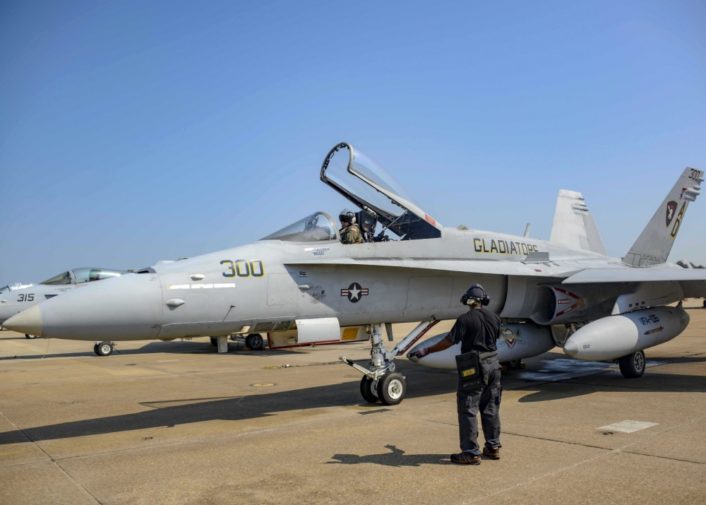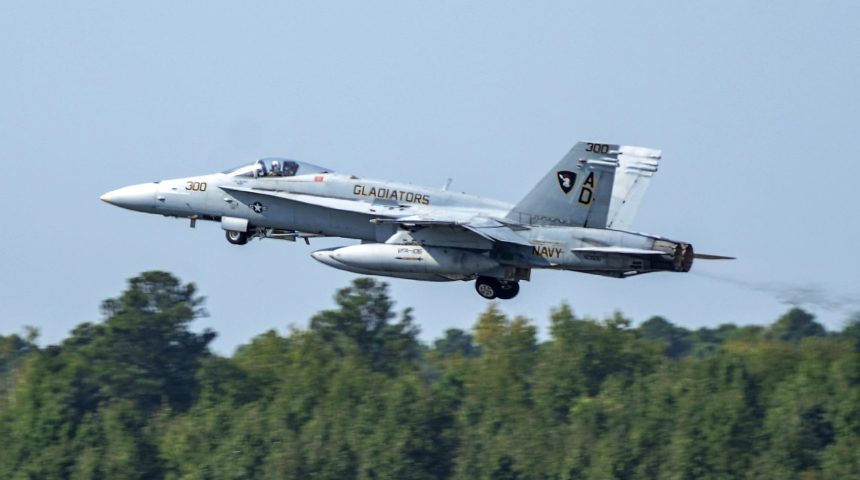The remaining Legacy Hornets will be handed over to Navy Reserve and Marine Corps.
On Oct. 2, 2019 the last US Navy F/A-18C Hornet performed its official final active duty flight at Naval Air Station Oceana, Virginia, escorted by three F/A-18F Super Hornets. “Today marked the final United States Navy F/A-18C Operational Hornet flight. Its technological innovation was continued on the F/A-18 E/F/G aircraft and helped the U.S. Navy transition from 4th to 5th generation aircraft,” said the Commodore, Command Strike Fighter Wing Atlantic, Capt. Brian Becker.
The aircraft, BuNo 163506 modex AD-300, was assigned to VFA-106 Gladiators in 1988 and remained with the squadron for its entire 31 years of service. After this final flight, it will be officially removed from the US Navy’s inventory and will begin its decommissioning phase, where all the usable parts are removed, before facing the final demolition.
Strike Fighter Squadron 106 (VFA-106) is the Navy’s East Coast Fleet Replacement Squadron, which trains naval aviators to fly the F/A-18 Super Hornet. Before this last flight it operated a mixed fleet of F/A-18C/D Hornets and F/A-18E/F Super Hornets. The Gladiators are also one of the squadrons that made up the US Navy’s Tac Demo Teams, together with the Flying Eagles of VFA-122 out of NAS Leemore, California.

This final F/A-18C flight of the Gladiators comes after the type’s last flight and retirement from the last deployable Legacy Hornet squadron, VFA-34 Blue Blasters, on Feb. 1, 2019 at NAS Oceana. During the last year, VFA-106 has handed over about 50 F/A-18 Hornets to various Navy Reserve and U.S. Marine commands, according to the Navy’s statement. As our editor David Cenciotti wrote back in February:
Although they will be officially retired in a matter of days, some F/A-18A+ Hornets (where “+” designates aircraft equipped with AN/APG-73 radars instead of the original AN/APG-65) will continue to serve in the fleet adversary support role with the Reserve as part of VFC-12 from NAS Oceana and VFA-204 from NAS New Orleans Joint Reserve Base. The Blue Angels will also continue flying their Legacy Hornets while transitioning to the Super Hornets.
“Legacy Hornets” remain in service with the U.S. Marine Corps that plans to fly the F/A-18Cs until they are replaced by the F-35B STOVL variant Lightining II stealth aircraft.
Some of the Legacy Hornets that were not transferred to other commands have been delivered to Davis-Monthan AFB, where the aircraft will be kept in storage by the 309th Aerospace Maintenance and Regeneration Group (AMARG) at the local “Boneyard”.
In fact, some of the U.S. Navy F/A-18A+ and C in better conditions have already been delivered to Davis-Monthan AFB, near Tucson, Arizona, where the aircraft will be kept in storage by the 309th Aerospace Maintenance and Regeneration Group (AMARG) at the local “Boneyard”: they will be cocooned in special materials just in case someone needs them to be put back into service. Something that is useful every now and then. For instance, back in 2016, the U.S. Marine Corps pulled some 30 Legacy Hornets from AMARG and rushed them to service in order to complement its fleet active F/A-18A/B/C/Ds.








